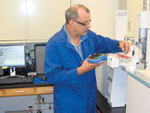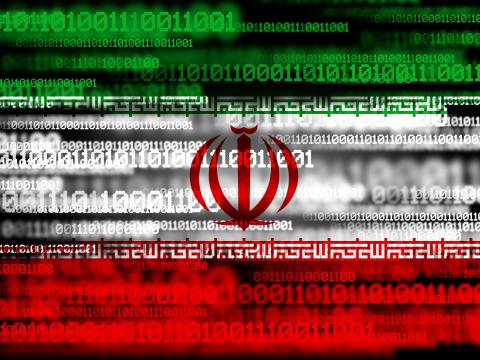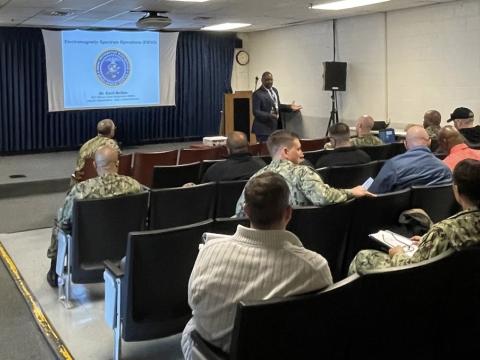Science Solves Problems From Theory to the Field
 |
The National Security Directorate at Pacific Northwest National Laboratory (PNNL) is developing technologies that could be used in tandem at personnel and vehicle chokepoints. The PNNL’s explosive-detection expertise results in multiple anti-explosives technologies that can be deployed in a range of uses. |
The National Security Directorate staff working at the Pacific Northwest National Laboratory is tackling some of the most difficult problems facing the nation and the world by building upon a strong foundation of fundamentals. From basic research to full-fledged fielding, the scientists run the gamut of project development, serving clients in a variety of disciplines—even some that may not typically come to mind as associated with an energy laboratory. The man in charge of it all sees good times ahead for the projects, whether they are conventional or offbeat.
Barry Merrill serves as the associate laboratory director for the National Security Directorate at Pacific Northwest National Laboratory (PNNL),
The PNNL’s history dates back to the Hanford Laboratory as well as the Manhattan Project, which developed the atomic bomb. “That heritage serves us well not only in the nonproliferation arena but also in the detection of weapons of mass destruction whether for counterterrorism or the DOD [Defense Department] threat spectrum,” Merrill says. However, now instead of development, suppression is the goal. “The intent is can we actually discover early and understand what signatures might indicate a threat before something happens,” he says.
Merrill also explains that each national laboratory has specific focuses. In the PNNL’s case, the emphasis is on discovery and exploitation, threat detection and mitigation. “We believe that is where we are noted as leaders,” he says.
In general, Merrill says his personnel work in the nonproliferation, counterterrorism, cybersecurity, borders and maritime technology arenas. “I don’t want to give the impression we solve everybody’s problems,” he explains. “We only focus on what we do best.” Because the national laboratories have different areas of expertise, they often work collectively and collaboratively to solve problems. “The end result is that you’re bringing not just one organizational perspective, but bringing a much more powerful entity to bear on those problems,” he says.
Early detection and warning in different arenas are the most important challenges facing his directorate, Merrill says. “That’s the holy grail, if you will, because the sooner you know something the sooner you can attempt to stop it,” he adds. Finding better and faster ways to carry out that work as well as connecting the dots between pieces of data, then making the information usable, are all issues the directorate faces as it moves forward.
The National Security Directorate represents half of the volume of the entire laboratory’s business and performs an array of services for national security clients including the U.S. Department of Homeland Security (DHS), the U.S. Defense Department and the intelligence community.
The National Nuclear Security Administration is the directorate’s largest single client. “Work can entail pretty basic research to actual applied applications of technology in the field,” Merrill explains. He adds that “it’s very, very valuable to us” to have people who know the problems associated with fielding technology talk to the people developing the technology.” This end-to-end communication within the directorate and with those outside it enhances development efforts; otherwise researchers in the early phases actually might not solve the right problems from the field.
To further improve projects, the directorate employs personnel engaged in policy activities to ensure developers understand how technology and policy affect each other. Merrill uses the example of an arms control situation or treaty verification in which negotiators are trying to agree to a policy. They need to know if certain technologies exist and what can be done with them. “It’s really critical that we provide all those different dimensions at one time,” he says.
Laboratory leads for client sets on particular projects are tasked with understanding the needs of those groups. The directorate has no staff directly assigned to that purpose, so it pulls in the right people for the jobs. “They’re the eyes and ears of the client,” Merrill explains. He continues that these employees work to bring the right needs and opportunities to the attention of the laboratory and the directorate so they can write winning proposals.
Those proposals result from gaps in capabilities that laboratory personnel have identified or through requests from outside agencies. Merrill says that when directorate employees believe the institutional knowledge could help solve a problem, they seek funding for the work. At other times, clients want to access the capabilities in the directorate so they ask for proposals on certain projects. The relationship managers help coordinate these different interactions, understand clients’ needs and resources, and keep tabs on events.
Different missions require different standards. Merrill explains that the devices developed for nuclear proliferation detection can be different than those used with a terrorism nuclear threat. In the former, professionals look to detect gases in the atmosphere from a nuclear explosion, while the latter involves activities such as establishing monitoring posts and detectors at borders. But no matter what the threat, those interested in deterring it have to look for certain telltale signs, also called signatures. Whether threats are chemical, nuclear or biological, certain signatures are constant during proliferation, terrorism or counterterrorism activities.
 |
A PNNL chemist loads fuel samples into a gas chromatograph for chemical forensic "fingerprinting" analysis. The Internal Revenue Service (IRS) conducts various fuel sampling and analysis activities to ensure compliance with applicable statutes and regulations. Samples are collected nationwide by local IRS fuel compliance agents and sent to the PNNL for analysis. A range of sophisticated chemical forensic, chemical analysis and fuel characterization capabilities has been developed and employed. |
“There’s clearly a number of large projects in the nonproliferation arena,” Merrill states, and “this is where we as a nation are working across the globe to secure loose radioactive sources so the likelihood of them being used in a dirty bomb is significantly reduced.”
In addition to those projects, the associate director highlights other work that scientists are carrying out that have broad interest. One of these efforts builds on work to develop forensic analysis methods for chemical, nuclear and biological characterization at the ultratrace level. Researchers are taking those capabilities and applying them to a project for the Internal Revenue Service to detect and determine tax evasion.
Based on chemical fingerprints, laboratory personnel can figure out if the appropriate taxes have been paid on fuels. Using ultratrace detection technologies, the scientists developed a means to determine if someone has attempted to mask the dye placed in taxable fuels or has made other efforts to avoid paying the taxes such as using nontaxable fuel on the highway. Farm diesel, for example, is taxed differently than road diesel, so tax evaders might try to hide the type of diesel they use. Merrill explains that it took a lot of foundational research to achieve these capabilities as well as to automate them so they deploy to the field quickly and can be used by nonscientists.
Another project in the directorate focuses on developing next-generation screening technology such as the millimeter wave system. “Based on a lot of what we’ve done in the past, we’re trying to look at standoff technologies to more rapidly and at a distance screen moving targets within these boundaries,” Merrill explains. “That in and of itself is a major challenge.” Scientists already have shown that the millimeter wave technology works in close proximity, but now they have to determine if it can be used farther away from the target. The DHS and Defense Department are sponsoring the work, with at least some of the interest coming from a desire to be able to screen people greater distances from forward operating bases. This would reduce the threat of suicide bombers unleashing their weapons at base entry points. “There’s a lot of work to be done, but I think there are some promising approaches that are out there,” Merrill says.
In other work, scientists are taking advantage of the PNNL’s computer science capabilities to develop new methods to classify and analyze video data. “This technology can do, we believe, for video what Google search algorithms have done for textual data,” Merrill states. The work will assist with intelligence sorting, storage, retrieval tasks, as well as with drawing inferences from video, and it is compatible with data-intensive computing approaches. The capabilities are required for high-throughput video analysis. The work will help analyze the huge amounts of video data collected through various methods.
“Clearly what we bring is some of our foundational science, because without science we really aren’t a national laboratory,” Merrill says. “If you’re not really working the hard problems overall, then you’re not really going to contribute.” He explains science as making discoveries, elaborating that the community can make incremental increases or major breakthroughs. “Really you need to do both,” Merrill states. The first step is to use science to look at problems in a new way. Then, personnel have to engineer capabilities people actually can use. “I think that a strength that we have is taking that science and moving it into the solutions arena,” he says.
Directorate personnel combine development and application in projects such as installing radiation portal monitors at border crossings. It challenges those involved because every location is different and requires analysis of how best to employ the detector. The scientists on the back end do the research to make the technology possible, and the engineers on the front end make it work.
An area Merrill would like to advance is the rate at which technology reaches users. “Right now there’s always that valley of death,” he says. “Someone will pay for development or a prototype, [but] getting that turned into a commercial product has historically been a very lengthy process. We would like to figure out how we can advance the readiness of that prototype and at the same time better figure out how we can find that commercial partner that will take it to marketplace. I think that’s best for the nation, and I think all the labs would agree with that.”
Another challenge for the directorate and the entire science and technology community is hiring employees with the necessary skills. Merrill says nuclear engineers with a real understanding of the work and with experience are particularly hard to find. Computer scientists also are hard to recruit because their skills are in such high demand. Another challenge is hiring personnel who can obtain security clearances and finding clearable employees willing to go through the process. “There are people who would just as soon not have a security clearance, and you have to respect that,” Merrill explains. “But in our world, it’s very difficult. Not everyone has to have a clearance, but the majority require some level of clearance.”
To overcome personnel challenges, the PNNL has established outreach programs with universities to build relationships. Merrill says this has gone well, but he still faces an issue of certain skills falling by the wayside, though the laboratory works constantly and aggressively to counter that effect.
In the last five years the average age of laboratory employees dropped from 54 to 45. “That’s a fairly significant change,” Merrill states. “That obviously doesn’t obviate the need for institutional knowledge. You can’t quantify that the same way you can an age level.”
PNNL personnel work together closely even when in different directorates or on different projects. Of the approximately 4,000 laboratory employees, more than 2,000 of them have worked on national security missions at some point in the past year, Merrill estimates. “This is a hallmark ... I just can’t emphasize it enough...,” he says. “While we are mission focused, we want to make sure we bring the best and brightest that we have to those solutions.”
WEB RESOURCES
PNNL National Security Directorate: www.pnl.gov/nationalsecurity
Office of Global Threat Reduction: http://nnsa.energy.gov/nuclear_nonproliferation/1550.htm
The
| Centers Expand National Security Missions At the Pacific Northwest National Laboratory (PNNL), scientists in the National Security Directorate work to solve difficult problems. But sometimes finding the best answers requires a more focused approach. The laboratory has established specific centers in other locations and even within the laboratory itself that concentrate on various areas critical to security. These organizations fall under the laboratory’s umbrella, and they bring together personnel from different disciplines to find solutions in a collaborative environment. One of the most prominent of these facilities is the The Another group strongly centered on collaboration is the National Visualization and Analytics Center (NVAC) established by the U.S. Department of Homeland Security in 2004. “This is a collaboration among academia, industry, government and national laboratories to create and deploy visual analytics technology to help counter future terrorist attacks,” Merrill says. “This is again a very large consortium. We just happen to be the ones in the center of this particular wheel.” NVAC is located within the PNNL in In the energy arena, the |




Comments